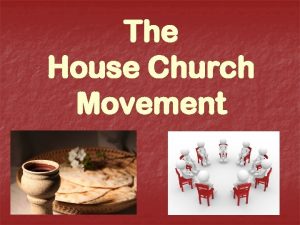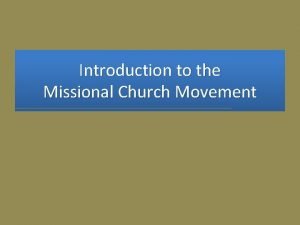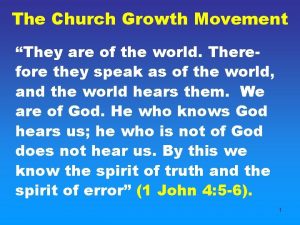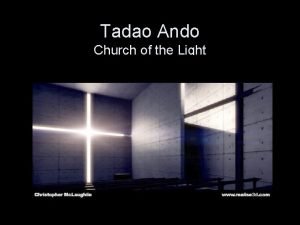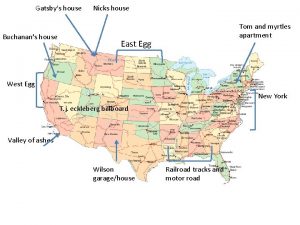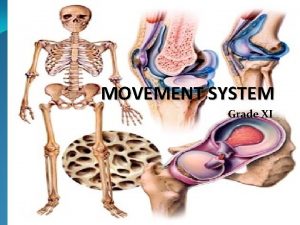The House Church Movement In the Light on









![The aversion is to one person doing most [or all] of the teaching. We The aversion is to one person doing most [or all] of the teaching. We](https://slidetodoc.com/presentation_image_h2/aeea6da9b30edb8ce8af2d45b7da4e5f/image-10.jpg)
















![The Great Divide “Listening to three faiths [Jews, Muslims, and Christians] articulate their differences, The Great Divide “Listening to three faiths [Jews, Muslims, and Christians] articulate their differences,](https://slidetodoc.com/presentation_image_h2/aeea6da9b30edb8ce8af2d45b7da4e5f/image-27.jpg)














![“Paul emphasizes the [doctrinal] significance of Christ as the Passover lamb, but he does “Paul emphasizes the [doctrinal] significance of Christ as the Passover lamb, but he does](https://slidetodoc.com/presentation_image_h2/aeea6da9b30edb8ce8af2d45b7da4e5f/image-42.jpg)
![“This suggests that the Passover setting is important historically and [doctrinally], but not liturgically. “This suggests that the Passover setting is important historically and [doctrinally], but not liturgically.](https://slidetodoc.com/presentation_image_h2/aeea6da9b30edb8ce8af2d45b7da4e5f/image-43.jpg)
![“If the early Church did not set the celebration of the [Lord’s Supper] in “If the early Church did not set the celebration of the [Lord’s Supper] in](https://slidetodoc.com/presentation_image_h2/aeea6da9b30edb8ce8af2d45b7da4e5f/image-44.jpg)














- Slides: 58

The House Church Movement In the Light on NT Assemblies 1

Viola and Barna, Pagan Christianity? In 2008, this book appeared with the subtitle: Exploring the Roots of our Church Practices. Apparently, these authors have become disenchanted with “the institutional church” and plead for “restoration” of the authentic, “organic church. ” 2

An “Organic church” is described by one reviewer as “Spirit-led, ” with “openparticipatory meetings, ” and “nonhierarchical leadership. ” 3

Many Designations simple church, organic church, koinos church, home church, relational church, participatory church, radical church, family integrated church, and age integrated church. 4

Ah, yes, this is what the world needs. An organic church restoration movement! 5

Radical Restoration The first words of La. Gard Smith’s book Radical Restoration: “As we begin our quest for radical restoration of first-century faith and practice. . . ” 6

Critical of Formal Worship Smith: “mostly an orchestrated religious spectacle for which we have reserved seats each week” (154). Atkerson: a “spectator’s sport” (36). 7

Opposed to “Pulpit Ministry” Smith: “The very concept of worship focused around a pulpit flies in the face of the dynamic, mutually participatory house churches in the apostolic age. Houses don’t have pulpits” (211). 8

Actually, this criticism is not about pulpits. Elevation for the purpose of being seen and heard is a matter of common sense. For example, Jesus taught on a hillside. 9
![The aversion is to one person doing most or all of the teaching We The aversion is to one person doing most [or all] of the teaching. We](https://slidetodoc.com/presentation_image_h2/aeea6da9b30edb8ce8af2d45b7da4e5f/image-10.jpg)
The aversion is to one person doing most [or all] of the teaching. We should use “our own elders” as “teaching pastors, ” and our “pulpit ministers” as “pulpit-less evangelists” (212). 10

Mutual edification is the model to follow: Interestingly, this idea is not new among brethren (Sommer, Ketcherside, etc. ). Preachers evangelize outsiders (the world); elders teach insiders (the church). 11

But see 1 Corinthians 3: 4 -9; Romans 1: 15. Paul had stayed at Ephesus 2 years (Acts 19: 10) and requested Timothy to remain there (1 Timothy 1: 3). 12

Organization of the Church La. Gard Smith writes, “There is nothing to rule out the possibility that the role of elders in the early church might well have encompassed more than one level of involvement -- even simultaneously. 13

“Perhaps there were elders shepherding the disciples in each house, depending upon their size and make-up. 14

“And perhaps elder oversight may have been exercised throughout a group of house churches which collectively comprised a larger, recognizable ‘congregation. ’ 15

“More thought-provoking for us, of course, is the third possibility -- that elders in individual house churches might also have come together as a group of city-wide elders to discuss matters of importance to the entire community of believers…. 16

“nothing necessarily precludes ‘Jerusalem’s elders’ from being gathered from among elders in a multiplicity of house churches” (178). 17

When one hears among the cries for “radical restoration” that “we’ve simply never given much thought, if any, to city-wide elders” (La. Gard Smith 172 -173) surely those who share this view must be deaf to the debate on this matter that has raged from the time of Ignatius until now. 18

If these persons contend that elders may oversee several churches of one city (such as Jerusalem, Acts 15: 2), then why not all the churches of an entire province (such as Judea, Acts 11: 29 -30; 1 Thess. 2: 14; Gal. 2: 14). 19

Or, perhaps, all the churches of several provinces (such as Pontus, Galatia, Cappadocia, Asia, and Bithynia, 1 Pet. 1: 1; 5: 2). 20

This idea of city-wide elders appears to be derived from an unverifiable assumption (whether true or not) that there were many “house churches” in Jerusalem. 21

From this assumption, the unwarranted conclusion is drawn that a single group of elders (Acts 15: 2, 4, 23) would have overseen numerous churches. 22

Where Christians Assembled In the temple court (Acts 2: 46). In houses (Romans 16: 5; 1 Corinthians 16: 19; Philemon 2). By the river side (Acts 16: 13). In an upper room---third story (Acts 20: 7 -9). Perhaps, in a synagogue-like place (James 2: 2). 23

A Matter of General Agreement God’s word does not need to be restored, unless one might believe that it has been grossly corrupted in transmission. What we really need to do is believe God’s word—become thoroughly acquainted with it—and do God’s will. 24

If we abide by God’s word, the sowing of this seed will produce both New Testament Christians and New Testament churches. 25

The Lord’s Supper 26
![The Great Divide Listening to three faiths Jews Muslims and Christians articulate their differences The Great Divide “Listening to three faiths [Jews, Muslims, and Christians] articulate their differences,](https://slidetodoc.com/presentation_image_h2/aeea6da9b30edb8ce8af2d45b7da4e5f/image-27.jpg)
The Great Divide “Listening to three faiths [Jews, Muslims, and Christians] articulate their differences, how deep is the divide that Jesus introduced. The Muslim worship service consisted mostly of reverential prayers to the Almighty. The Jewish service incorporated reading from Psalms and the Torah and some warmhearted singing. 27

“Any of those elements can be found in a Christian service. What divided us from the others was the celebration of the Lord’s Supper. ‘This is my body, broken for you, ’ our leader read, before distributing the bread---Christ’s body, the divergence point” (Philip Yancey, The Jesus I Never Knew 54). 28

The Lord’s Supper in the Assembly 29

Two Positions Lord’s supper: partaken as part of a larger meal (not praised; results in condemnation). Lord’s supper: partaken alone (authorized by the Lord). 30

First Position Upheld in Radical Restoration “. . . the most universally-overlooked feature of the Lord’s Supper as practiced in the primitive church is that – from all appearances – it was observed in conjunction with a fellowship meal. That is, a normal, ordinary meal with the usual variety of food. 31

However, unlike normal, ordinary meals, this combined table fellowship and memorial was shared among the disciples for the special purpose of strengthening, not just their physical bodies, but their common bond in the spiritual body of Christ. . . From its very inception, therefore, the Lord’s Supper was an integral part of a real meal” (128 -129). 32

1 Corinthians 11: 17 -34 The Corinthians obviously were out of order in their assemblies. 33

Problem A perversion of the Lord’s supper (1 Cor. 11: 17 -34). 34

Tentative outline of the section: A. The wrong practice (vv. 17 -22). Contrasts in eating and drinking: What is done “In houses” (v. 22) or “at home” (v. 34). What should be done “when you come together in assembly” (v. 18, 20; cf. vv. 17, 33, 34). 35

B. The authorized practice (vv. 23 -32). Pattern (vv. 23 -25). Paul’s observations (vv. 26 -29). “As often as” (v. 26 a). “Declare the Lord’s death until He comes” (v. 26 b). 36

Tragic effects of abuse: “Guilty of the body and blood” (v. 27), so examine yourself (v. 28). “Weak, ” “sickly, ” “sleep” (v. 29). 37

Proper self-evaluation to avoid condemnation (vv. 31 -32). C. Two inferences (vv. 33 -34). Welcome one another for the proper practice in the assemblies (v. 33). Satisfy hunger at home (v. 34 a). D. Concluding remark (v. 34 b). 38

Notes: Corresponding statements (inclusions): “I praise you not” (identical, vv. 17, 23). “Since you come together not for the better but for the worse” and “lest you come together for judgment” (similar, vv. 17, 34). 39

Paganism, Not Passover, Accounts for the Erroneous Practice Routledge says, “It is worth noting … that from earliest times the Church has separated out the [Lord’s Supper] elements of bread and wine, which became part of a weekly celebration, from the rest of the Passover meal. (cont’d) 40

“The writers of the Synoptic Gospels do present the Last Supper as a Passover meal; but they emphasize only the bread and wine, and do not refer to other traditional elements such as the lamb and bitter herbs. 41
![Paul emphasizes the doctrinal significance of Christ as the Passover lamb but he does “Paul emphasizes the [doctrinal] significance of Christ as the Passover lamb, but he does](https://slidetodoc.com/presentation_image_h2/aeea6da9b30edb8ce8af2d45b7da4e5f/image-42.jpg)
“Paul emphasizes the [doctrinal] significance of Christ as the Passover lamb, but he does not link this with his instructions about the Lord’s Supper. 42
![This suggests that the Passover setting is important historically and doctrinally but not liturgically “This suggests that the Passover setting is important historically and [doctrinally], but not liturgically.](https://slidetodoc.com/presentation_image_h2/aeea6da9b30edb8ce8af2d45b7da4e5f/image-43.jpg)
“This suggests that the Passover setting is important historically and [doctrinally], but not liturgically. ” (Robin Routledge, “Passover and the Last Supper, ” Tyndale Bulletin 53: 2 (2002) 205. 43
![If the early Church did not set the celebration of the Lords Supper in “If the early Church did not set the celebration of the [Lord’s Supper] in](https://slidetodoc.com/presentation_image_h2/aeea6da9b30edb8ce8af2d45b7da4e5f/image-44.jpg)
“If the early Church did not set the celebration of the [Lord’s Supper] in the context of a Passover meal we must approach the current trend towards their reunion with some caution” (Routledge 204 -205). 44

I might add, celebration of a Passover meal would have been problematic in a congregation that was heavily Gentile in composition. 45

1 Corinthians 14: 27 -35 46

Problem Unauthorized talking in the assemblies. 47

Tongue Speakers (vv. 27 -28) Paul’s apostolic commands: One may speak At the most three may speak one at a time Interpret what is said Others “keep silent” 48

Prophets (vv. 29 -31) Paul’s apostolic commands: Speak one by one The others must “keep silent” That all may learn 49

Women (vv. 33 b-35) Paul’s apostolic commands: “Keep silent in the churches” Not permitted to speak Submissive Learn from husbands at home “Shameful for women to speak in church” 50

Unmarried women included as well in 1 Timothy 2: 11 -12. Learn in silence with all submission A woman not permitted to teach or to have authority over a man, but to be in silence 51

Rather commonly, however, those within the house church movement encourage women in the assembly to share their comments during the Lord’s supper. 52

Loose Reasoning I stand amazed at how sociologists, social historians, and others make so many unwarranted assumptions about the assemblies of God’s people in the first century A. D. 53

A Few Examples 1) Early Christian meetings were “talkative, passionate, and sometimes quarrelsome circles that met to read Paul’s letters over their evening meals in private homes” (E. A. Judge, “the Social Identity of the First Christians, ” Journal of Religious History 11 (1980) 201 -217. 54

2) “There were apparently various meetings of Christians in homes in Corinth, and only occasionally did “the whole ekklēsia gather, apparently for the Lord’s Supper” (Witherington, Conflict and Community 91). 55

3) “Finally, we have our Catholic and Protestant heritage to thank for the highlystructured worship format which we typically follow. Compared with the intricacies of the Catholic Mass, of course, we are far from the ‘smells and bells’ of high church observance. Even so, our 56

own set-piece, traditional services (and, more lately, our slickly-managed, hi-tech contemporary worship productions) stand in sharp contrast to the spontaneous, mutually-participatory, and intimate worship of the first-century believers” (F. La. Gard Smith, Radical Restoration: A Call for Pure and Simple Christianity 61). 57

Conclusion Ultimately we all have only one source on which to base our belief, namely, the Bible. We must be steadfast in the obedience of faith. 58
 House church movement
House church movement Light light light chapter 23
Light light light chapter 23 Into the light chapter 22
Into the light chapter 22 Light light light chapter 22
Light light light chapter 22 Missional church movement
Missional church movement Church growth movement
Church growth movement Movement and non movement area
Movement and non movement area Locomotor movements examples in dance
Locomotor movements examples in dance Cldt church house
Cldt church house Ando church of light
Ando church of light Meaning of acceptance house
Meaning of acceptance house Snug bugs home
Snug bugs home Banished boarding house vs house
Banished boarding house vs house My house shall be called
My house shall be called They went house to house
They went house to house Branded house house of brands
Branded house house of brands Lokesh kumar jangid
Lokesh kumar jangid Mastoid reservoir sign meaning
Mastoid reservoir sign meaning Light house erp
Light house erp Put out the light
Put out the light Difference between light dependent and light independent
Difference between light dependent and light independent The bouncing off of light
The bouncing off of light Material blocks light
Material blocks light Hát kết hợp bộ gõ cơ thể
Hát kết hợp bộ gõ cơ thể Ng-html
Ng-html Bổ thể
Bổ thể Tỉ lệ cơ thể trẻ em
Tỉ lệ cơ thể trẻ em Gấu đi như thế nào
Gấu đi như thế nào Thang điểm glasgow
Thang điểm glasgow Chúa yêu trần thế alleluia
Chúa yêu trần thế alleluia Môn thể thao bắt đầu bằng chữ đua
Môn thể thao bắt đầu bằng chữ đua Thế nào là hệ số cao nhất
Thế nào là hệ số cao nhất Các châu lục và đại dương trên thế giới
Các châu lục và đại dương trên thế giới Công của trọng lực
Công của trọng lực Trời xanh đây là của chúng ta thể thơ
Trời xanh đây là của chúng ta thể thơ Mật thư anh em như thể tay chân
Mật thư anh em như thể tay chân Phép trừ bù
Phép trừ bù Phản ứng thế ankan
Phản ứng thế ankan Các châu lục và đại dương trên thế giới
Các châu lục và đại dương trên thế giới Thể thơ truyền thống
Thể thơ truyền thống Quá trình desamine hóa có thể tạo ra
Quá trình desamine hóa có thể tạo ra Một số thể thơ truyền thống
Một số thể thơ truyền thống Cái miệng xinh xinh thế chỉ nói điều hay thôi
Cái miệng xinh xinh thế chỉ nói điều hay thôi Vẽ hình chiếu vuông góc của vật thể sau
Vẽ hình chiếu vuông góc của vật thể sau Biện pháp chống mỏi cơ
Biện pháp chống mỏi cơ đặc điểm cơ thể của người tối cổ
đặc điểm cơ thể của người tối cổ Thế nào là giọng cùng tên?
Thế nào là giọng cùng tên? Vẽ hình chiếu đứng bằng cạnh của vật thể
Vẽ hình chiếu đứng bằng cạnh của vật thể Fecboak
Fecboak Thẻ vin
Thẻ vin đại từ thay thế
đại từ thay thế điện thế nghỉ
điện thế nghỉ Tư thế ngồi viết
Tư thế ngồi viết Diễn thế sinh thái là
Diễn thế sinh thái là Dot
Dot Số.nguyên tố
Số.nguyên tố Tư thế ngồi viết
Tư thế ngồi viết Lời thề hippocrates
Lời thề hippocrates Thiếu nhi thế giới liên hoan
Thiếu nhi thế giới liên hoan
